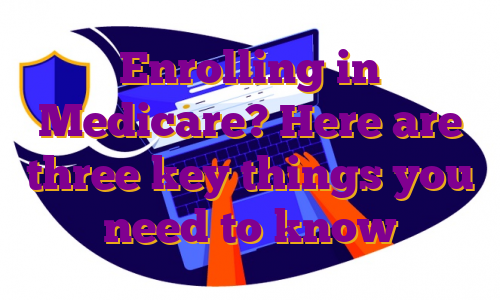andresr | E+ | Getty ImagesMedicare may seem like a maze when you first try to navigate it.After all, there are different “parts” to the federal health insurance program, which provides coverage for about 56.5 million individuals in the 65-and-older crowd. And, whether you’re reaching the eligibility age of 65 or you are older and switching from workplace insurance to Medicare, there are some important factors to consider that affect your wallet.First, however, it’s worth knowing the basics: Original Medicare consists of Part A (hospital coverage) and Part B (outpatient care).More from Investor Toolkit:
3 tips for paying down your credit card balances
Democrats call for action on Social Security reform
Investors are flocking to green energy fundsSome beneficiaries choose to get those benefits delivered through an Advantage Plan (Part C), which typically includes prescription drug coverage (Part D). Others stick with original or basic Medicare and, possibly, pair it with a standalone Part D plan and a so-called Medigap policy.Here are three key things to be aware of as you prepare to enroll.1. It’s going to cost youMedicare is not free.”This comes as a surprise to so many beneficiaries who have paid [payroll] taxes throughout their working lifetimes and assumed this would mean Medicare would be ‘paid up’ by the time they turn 65,” said Danielle Roberts, co-founder of insurance firm Boomer Benefits.”Those taxes will mean no premiums for Part A, but Parts B and D have premiums that beneficiaries pay monthly throughout their retirement years,” Roberts said.Premium-free Part A is available as long as you have at least a 10-year work history of paying into the system via payroll taxes. If not, monthly premiums could be as much as $499 in 2022, depending on whether you’ve paid any taxes into the Medicare system at all.Spouses without their own work history may qualify for premium-free Part A as well.Part A also has a deductible of $1,566, which applies to the first 60 days of inpatient hospital care in a benefit period. For the 61st through 90th days, beneficiaries pay $389 per day, and then $778 per day for 60 “lifetime reserve” days.Meanwhile, Part B’s standard monthly premium is $170.10 this year. However, some beneficiaries pay more through income-adjusted surcharges.”Many of my high-income earners are shocked at how much Medicare premiums will cost them in retirement,” said Elizabeth Gavino, founder of Lewin & Gavino and an independent broker and general agent for Medicare plans. The government uses your tax return from two years earlier to determine whether you’ll pay extra. To request a reduction in that income-related amount due to a life-changing event such as retirement, the Social Security Administration has a form you can fill out.Part B also has a deductible: $233 in 2022. Once that’s met, beneficiaries generally are responsible for 20% of covered services. Part D premiums, deductibles and copays depend on the specifics of the coverage. The average premium this year is about $32, according to the Centers for Medicare & Medicaid Services. And, as with Part B, higher earners are charged extra through IRMAAs.2. Missing key deadlines can mean paying extraIf you’re planning to sign up for Medicare as soon as you’re eligible at age 65, you get a seven-month “initial enrollment period” that starts three months before the month of your 65th birthday and ends three months after it.Meanwhile, if you delayed signing up at age 65 because you continued to work and your employer coverage was acceptable (according to Medicare standards), you get eight months to enroll once your workplace plan ends.Regardless of the enrollment rules your subject to, missing the deadline to sign up for Part B can result in a life-lasting late-enrollment penalty. For each full year that you should have been enrolled but were not, you’ll pay 10% of the monthly Part B standard premium.”Many of my high-income earners are shocked at how much Medicare premiums will cost them in retirement.Elizabeth GavinoFounder of Lewin & GavinoPart D also has a late-enrollment penalty if you miss the deadline. For people signing up during their initial enrollment period at age 65, you get the same seven months for Part D as you do for Part B. However, if you’re beyond that window and your workplace coverage is ending, you get two months to enroll in Part D, whether as a standalone plan or through an Advantage Plan.The penalty is 1% of the national base premium for each month you didn’t have Part D or creditable coverage and should have.3. Supplemental insurance may make senseThe various costs associated with basic Medicare may be different if you have supplemental coverage.One option is to enroll in an Advantage Plan. While you would generally continue to pay your Part B premiums, many plans have a low or zero premium. And in addition to usually including prescription drug coverage, Advantage Plans also may offer extras such as dental, vision and hearing. Advantage Plans come with a cap on out-of-pocket spending, unlike basic Medicare. Their cost-sharing structures — i.e., deductibles, copays or coinsurance — also are different and vary from plan to plan.However, the annual maximum out-of-pocket can be high: in 2021, it averaged $5,091, according to the Kaiser Family Foundation. You also may be required to use certain doctors, hospitals and pharmacies.”These plans have networks of providers and some plans will require you to choose a primary care physician and get referrals to see certain providers and prior authorizations for many of the more expensive procedures, tests and surgeries,” Roberts said.Your other option is Medigap, which picks up some cost-sharing associated with basic Medicare, such as the Part A deductible or Part B copays. These policies are offered by private insurance companies as well, but are generally standardized — same-named plans offer identical benefits no matter which insurer sells it. Available Medigap policies are designated A, B, C, D, F, G, K, L, M and N and each offers a different level of coverage.However, they can be pricey, depending on the insurer and where you live. A 65-year-old woman in Dallas might pay under $100 monthly for Plan G, while in New York that same person would pay $278, according to the American Association for Medicare Supplement Insurance. And, generally speaking, those premiums rise over time.Choosing between an Advantage Plan or Medigap (or neither) can involve things that go beyond cost and depend on the specifics of your situation. This makes it worth consulting with either an experienced Medicare agent or your local State Health Insurance Assistance Program, otherwise known as SHIP, and neither would cost you anything for guidance.”There are many factors to consider when choosing between these two options,” Gavino said. .
Strategies can help you avoid paying extra for Medicare premiums
Morsa Images | DigitalVision | Getty ImagesFor some retirees, there’s an extra cost associated with Medicare premiums that can ambush their household budgets.Most Medicare enrollees pay the standard premium amounts for Part B (outpatient care) and Part D (prescription drugs). Yet an estimated 7% of Medicare’s 64.3 million beneficiaries end up paying extra because their income is high enough for income-related monthly adjustment amounts, or IRMAAs, to kick in, according to the Centers for Medicare & Medicaid Services.Whether you have to pay the surcharge is based on your modified adjusted gross income as defined by the Medicare program: your adjusted gross income plus tax-exempt interest income. For 2022, IRMAAs kick in when that amount is more than $91,000 for individuals or $182,000 for married couples filing joint tax returns. The higher your income, the larger the surcharge is.”You only have to go $1 over that [lowest] breakpoint and you’re subject to IRMAAs,” said certified financial planner Barbara O’Neill, owner and CEO of Money Talk, a financial education company. “If you’re close to that or close to going to a higher tier, you’ve really got to be proactive,” O’Neill said.In other words, there are some strategies and planning techniques that can help you avoid or minimize those IRMAAs. Here are four to consider:1. Focus on what you can control2. Consider converting to Roth IRA accountsOne way to keep your taxable income down is to avoid having all of your nest egg in retirement accounts whose distributions are taxed as ordinary income, such as a traditional IRA or 401(k). So whether you’ve signed up for Medicare yet or not, it may be worth converting taxable assets to a Roth IRA.Roth contributions are taxed upfront, but qualified withdrawals are tax-free. This means that while you would pay taxes now on the amount converted, the Roth account would provide tax-free income down the road — as long as you are at least age 59½ and the account has been open for more than five years, or you meet an exclusion.”You pay a little more now to avoid higher tax brackets or IRMAA brackets later on,” Meinhart said.It also helps that Roth IRAs do not have required minimum distributions, or RMDs, in the owner’s lifetime. RMDs are amounts that must be withdrawn from traditional IRAs as well as both traditional and Roth 401(k)s once you reach age 72.When RMDs from traditional accounts kick in, your taxable income could be pushed up enough that you become subject to IRMAAs, or to a higher amount if you already were paying the surcharge.”A lot of people get into trouble by taking no money out of their 401(k) or IRA, and then they have their first RMD and it puts them in one of those IRMAA brackets,” Meinhart said.3. Keep an eye on capital gainsIf you have assets that could generate a taxable profit when sold — i.e., investments in a brokerage account — it may be worth evaluating how well you can manage those capital gains. While you may be able to time the sale of, say, an appreciated stock to control when and how you would be taxed, some mutual funds have a way of surprising investors at the end of the year with capital gains and dividends, both of which feed into the IRMAA calculation. “With mutual funds, you don’t have a whole lot of control because they have to pass the gains on to you,” said O’Neill, of Money Talk. “The problem is you don’t know how big those distributions are going to be until very late in the tax year.”Depending on the specifics of your situation, it may be worth considering holding exchange-traded funds instead of mutual funds in your brokerage account due to their tax efficiency, experts say.For investments whose sale you can time, it’s also important to remember the benefits of tax-loss harvesting as a way to minimize your taxable income.That is, if you end up selling assets at a loss, you can use those losses to offset or reduce any gains you realized. Generally speaking, if the losses exceed the profit, you can use up to $3,000 per year against your regular income and carry forward the unused amount to future tax years.4. Tap your philanthropic sideIf you’re at least age 70½, a qualified charitable contribution, or QCD, is another way to keep your taxable income down. The contribution goes directly from your IRA to a qualified charity and is excluded from your income.”It’s one of the few ways you can really get money out of an IRA completely tax free,” Meinhart said. “And when you’re 72, that charitable distribution can help offset your required minimum distributions.”The maximum you can transfer is $100,000 annually; if you’re married, each spouse can transfer $100,000. .
What investment strategy must you follow to retire in 15 years?
I am a 46-year-old independent tax consultant and have almost ₹25 lakh as investments in the following funds: Axis Long Term Equity, Nippon Gold, Nippon Multicap, Nippon Growth, Nippon Banking, Nippon Pharma, Nippon Taxsaver, Birla Sunlife Frontline Equity, Birla Sunlife Midcap, Sundaram Large and Mid Cap, Sundaram Mid, HDFC Top 100, UTI Midcap, UTI Dividend Yield, IDFC Flexi Cap. Fund, SBI Consumption Opportunities, ICICI Long Term Equity Fund, ICICI Value and Discovery Fund and ICICI Technology Fund. I have also started a systematic investment plan (SIP) in the following funds since January 2022: Motilal Oswal Nasdaq 100 FoF, PGIM India Midcap Opportunities, Canara Robeco Bluechip Equity, Mirae Asset Emerging Bluechip , Parag Parikh Flexi Cap Fund and Kotak Small Cap Fund. I have also made a one-time investment in the following funds in January this year: PGIM India Flexi Cap Fund- ₹100,000, Axis Small Cap- ₹100,000, Axis Bluechip Fund – ₹100,000, Axis Midcap Fund – ₹100,000, Motilal Oswal Nasdaq 100 FoF – ₹75,000.00. I also have about ₹650,000 in shares, besides ₹500,000 in PPF and NSC. I have a Star health insurance policy and its annual premium is ₹25,000 for ₹30 lakh coverage. Please let me know if my investment strategy helps me to retire after 15 years. -Name withheld on request The portfolio is excessively diversified in our view and it may be a good idea to consolidate your overall holdings. Thus, as and when your schemes become long term and free of exit load, you may wish to retain 5-6 schemes in your overall retirement portfolio. You could consider retaining the ICICI Value Discovery Fund, Parag Parikh Flexicap Fund, MOSL NASDAQ 100 Fund, Mirae Emerging Bluechip Fund and Axis Small cap fund in your portfolio. While you do have other good schemes as well, managing a portfolio with too many schemes is rather cumbersome and therefore avoidable in our view. It is a good idea to do SIPs in the same schemes that you are using for lumpsum investments, and you may considering adding a scheme with UTI Nifty Index Fund – Direct Growth to your portfolio to get market returns at a low cost. Vishal Dhawan is a certified financial planner and founder of Plan Ahead Wealth Advisors, a Sebi registered investment advisory firm.
Subscribe to Mint Newsletters * Enter a valid email * Thank you for subscribing to our newsletter.
.
Choice between pre-tax and Roth 401(k) plans trickier than you think
Prathanchorruangsak | Istock | Getty ImagesWhether you’re a current employee or changing jobs, you may need to choose between pre-tax and Roth 401(k) contributions, and it may be trickier than you expect.Here’s the difference: Pre-tax 401(k) deposits reduce your adjusted gross income, and the money grows tax-deferred, meaning you’ll pay levies on withdrawals. By contrast, Roth 401(k) contributions don’t provide an upfront write-off, but earnings are tax-free.However, there may be other tax trade-offs, so you’ll need to weigh the pros and cons before diverting funds, financial experts say.More from Personal Finance:
White House tries to figure out which student debt to forgive
There’s an ‘un-retirement’ trend amid this hot job market
How to beat back rising prices with Memorial Day dealsRoughly 86% of 401(k) plans offered a Roth account in 2020, up from 75% in 2019, according to the Plan Sponsor Council of America.”In general, the goal is to take deductions at a higher tax rate and distributions at a lower one,” said certified financial planner Ken Waltzer, co-founder and managing partner of KCS Wealth Advisory in Los Angeles. If you plan on more income or higher taxes in retirement, tax-free withdrawals from Roth contributions may make sense, and tax-deferred contributions may be better if you expect lower earnings and levies.But that’s not always a winning strategy, according to Michelle Gessner, a Houston-based CFP and founder of Gessner Wealth Strategies.”Investors are quick to discard the idea of making Roth contributions if they are in a high tax bracket because they want the deduction that comes with a regular 401(k) contribution,” she said.However, the upfront write-off may not be worth it if you worry about the consequences of taxable required minimum distributions, she said. Social Security and Medicare costsWhen someone withdraws tax-deferred money from a 401(k), it boosts their income, which may trigger levies on Social Security and hike Medicare premiums. The formulas for Social Security taxes, Medicare Part B and Medicare Part D use so-called modified adjusted gross income, or MAGI.If half of your Social Security payments plus MAGI is more than $34,000 ($44,000 for a joint return), up to 85% of those benefits may be taxable.However, the bigger issue for retirees above certain income levels may be the surcharge for Medicare Part B, known as the Income Related Monthly Adjustment Amount, or IRMAA. While the base amount for Medicare Part B premiums is $170.10 for 2022, payments go up once income exceeds $91,000 ($182,000 for joint filers). The calculation uses MAGI from two years prior. Roth withdrawals, however, won’t show up on tax returns, said Gessner, meaning retirees don’t have to worry about these distributions causing Medicare premium increases.Diversify taxesSince no one can predict future tax rates, you may also consider creating a mix of pre-tax and after-tax funds from a diversification standpoint, experts say.”It is great when clients have both Roth and traditional retirement savings,” said Catherine Valega, a CFP and wealth consultant at Green Bee Advisory in Winchester, Massachusetts.If you have both pre-tax and after-tax funds, it may provide more options to craft an efficient retirement income plan, she said. .










